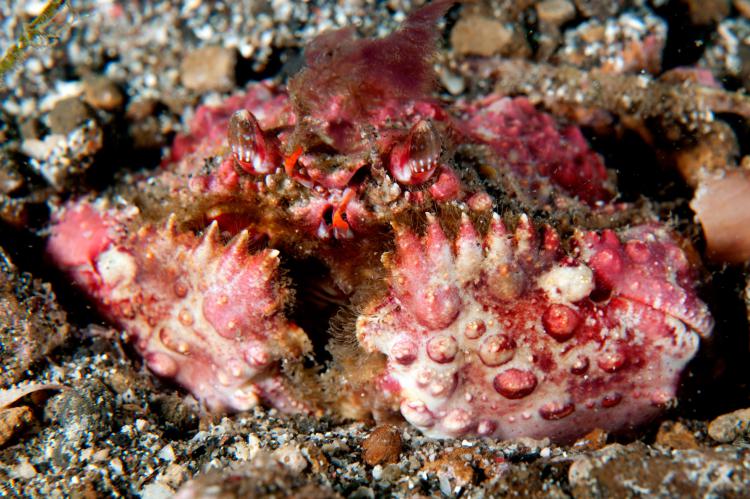Sulawesi: Muck Diving & Diversity
Sulawesi is one of those places on nearly every diver’s bucket list. If not, it ought to be. A dozen years ago, people would have thought you daft to go diving there, much less build a dive resort in an area dominated by dark volcanic sand. Yet in Sulawesi there are nearly two dozen resorts vying for divers’ dollars, yen and euros.
Tags & Taxonomy
Sulewesi came on my radar when I first set eyes on Roger Steene’s book, Coral Seas, published in 1998. At the time, the last thing on my wish list was another coffee table book. I had been diving nearly 40 years and thought I’d seen just about everything I wanted to see underwater. But when I spotted the weird, exotic animals in that book, I realized what I’d been missing. An inordinate number of them were photographed in Sulawesi.
My first trip to Sulawesi was in 2005 on the liveaboard Aqua One, motoring through Bunaken and Lembeh Strait. When I returned home and matched all the critters still missing against Steene’s book, I vowed to return. I’ve never been a fan of checklist diving, but after seeing shots of mimic octopuses, rhinopiases, bobbit worms and stargazers, I realized that I’d missed the boat. So, when the opportunity finally arose, nobody had to twist my arm.
This time, it would be a slow and leisurely two weeks, split between two land based resorts: Cocotinos in the Bunaken area, and Kasawari in Lembeh Strait. Bunaken Island features the dropoffs, walls and colorful invertebrate life we all associate with the tropical Indo-Pacific. Yet, there’s also excellent muck diving offshore. Lembeh Strait has a few coral reefs to go along with all the bottom dwelling critters. The good news is that both are within a two-hour drive from Manado’s airport, Bunaken on the western side of the peninsula and Lembeh to the east.
Muck diving
First, let’s define Sulawesi’s brand of muck diving. The substrate isn’t really muck, but dark brown to black volcanic sand. That’s important for several reasons. First, the big grains settle quickly instead of remaining in suspension and destroying visibility. Second, it’s okay for a diver to lie down on the bottom, allowing for eye level shots. No delicate corals will be smooshed, but watch out for urchins and stargazers and the like. Finally, the dark colors won’t be blown out by the lights of strobes, providing an excellent background for underwater photographs and videos.
Bunaken
Bunaken Island is about a 45-minute boat ride from Cocotinos Boutique Beach Resort. It’s a series of classic wall dives with virtually every inch covered by sponges, tunicates and hard corals. Clouds of anthias flitter about the reef, joined by fusiliers in the blue. What’s missing is big critters; a shark sighting was a big deal. But to me the big deals were mating nudibranchs, ribbon eels, a juvenile lionfish and an extremely cooperative jawfish. I kept peering down the wall, but the computer and Nitrox nixed those thoughts.
The first thing my guide, Tono, promised was to find me a pygmy seahorse. The first thing I replied was that everybody had pygmy seahorse photos, I’m not into super macro, so let’s find other things. Tono seemed relieved. He seemed to know where every frogfish of every color was hanging out, as well as every boxfish and pipefish. The best spot was a rubble pile with three sea horses and two kinds of scorpionfish. Despite the walls, I spent most of my dives at Cocotinos shooting macro.
Kasawari
At Kasawari Lembeh Resort, I renewed acquaintances with two Indonesian divers who had pioneered the art of muck diving: Nuswanto Lobbu and Ali Umasangadji. Nus is now the manager of Kasawari, complaining that his office duties preclude very much diving. Although he is a relative newcomer to underwater photography, Nus’ uncanny ability to find critters has resulted in images that make the pros jealous.
Ali, despite many years of guiding, still radiates joy when finding rare and exotic marine life. In Sulawesi’s muck, a shooter is almost totally dependent upon the guides. Occasionally, I was able to locate my own subjects, but for at least 80 percent of the images in this spread, credit must be shared with Tono, Ali, Robin, Hanni and Indra.
Critters
On the first night dive in Lembeh, I made a find of my own: a pair of mating crabs. The male was on top of the female, and slowly dragged her along the bottom. After a few strobe flashes, he seemed to resent this invasion of privacy and buried the female in the sand, leaving only her eyes protruding.
Mandarinfish
Mating mandarin fishes at dusk presented a different challenge. For those who haven’t tried shooting them, the exercise consists of 50 minutes of boredom followed by five minutes of chaotic action. That’s when the male and female suddenly spurt out of the coral maze into the water column, release their eggs and sperm, and dash back under cover. Common practice is to use a red modeling light to avoid inhibiting their nuptials. My problem was that three layers of red plastic made the light too dim to focus by.
On the following night, I used only one layer, which was like no red light at all. But I aimed it downward, until the mandarins began their upward sprint into ecstasy. Then, I was able to get the beam on them, autofocus and shoot. That technique resulted in about five times the keepers of the previous night. Mandarins are the most beautiful fishes on the reef, and they know it.
Bobbit worm
Another night critter on my wish list was a bobbit worm. A meter or more (...)
Download the full article ⬇︎

Originally published
X-Ray Mag #38
Indonesia - North Sulawesi | Honduras - Utila Island | Sharks - Sandtigers | Amazon - Pink Dolphins | Ecology - Cephalopods | Portfolio - Caelum Mero































